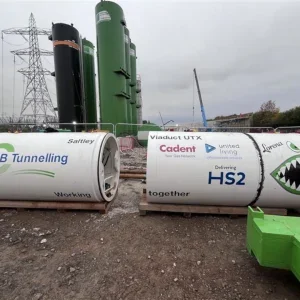The last of the project’s TBMs, named Grace, broke through on Saturday, after tunnelling more than 11km eastwards from National Grid’s New Cross substation in Southwark.
All 32.5km of the project’s underground route are now complete, and installation of 200km of high voltage cable is under way between substations at Wimbledon and Crayford.
In total the project will have shifted 900,000 tonnes of earth, with 99.98% of waste material diverted from landfill.
The LPT project’s new transmission infrastructure is due to be fully operational by 2026. It aims to reinforce and future-proof London’s electricity network as demand in the capital grows. It has involved tunnelling at depths of up to 60m under seven south London boroughs.
Phase 1 of the project was completed between 2011 and 2018, and carried the cable circuits north of the River Thames.
National Grid’s delivery partner, Hochtief-Murphy Joint Venture (HMJV), started the Phase 2 tunnelling works in March 2020.

HMJV project director Santiago Daniele said the project had been an incredible journey, “from taking over our tunnel drive sites a week after the Covid lockdown, to sinking eight shafts and undertaking five tunnel drives with four TBMs over the past three-and-a-half years”.
“With our final TBM drive breaking through at Eltham ahead of the original baseline programme, it’s testament to the collaboration, ingenuity and fantastic joint culture of all involved – despite all of the challenges faced,” said Daniele.
“We’re incredibly proud to be delivering for National Grid a scheme of such significance – and being their delivery partner of choice for complex major infrastructure involved in LPT Phase 2.” The four TBMs, Christine, Caroline, Edith and Grace, completed tunnelling in three sections between existing National Grid substations: Wimbledon-New Cross (12km); New Cross-Hurst (18km); and Hurst-Crayford (2.5km).
Breakthroughs previously took place at Eltham in June 2022 (TBM Christine tunnelling from Hurst); Wimbledon in July 2022 (TBM Caroline tunnelling from Kings Avenue); Crayford in January 2023 (Christine again tunnelling from Hurst); and Kings Avenue in April 2023 (TBM Edith tunnelling from New Cross).
Vertical shafts ranging between 9-15m in diameter and up to 55m in depth were constructed along the route, serving as waypoints for the TBMs, and providing access to the tunnels for maintenance now and when the network is operational.
In May, the Hurst substation site set a world record-breaking pour of cement-free concrete to fill the base of its 55m-deep shaft following TBM Christine’s two tunnel drives to Eltham and Crayford.
In another first for LPT, National Grid’s new Bengeworth Road substation on the tunnel route in Lambeth is being built free from greenhouse gas sulphur hexafluoride (SF6), which is used in electricity transmission to insulate the live electrical parts and to switch the flow of electrical current on and off. National Grid is aiming for its infrastructure to be SF6-free by 2050.







